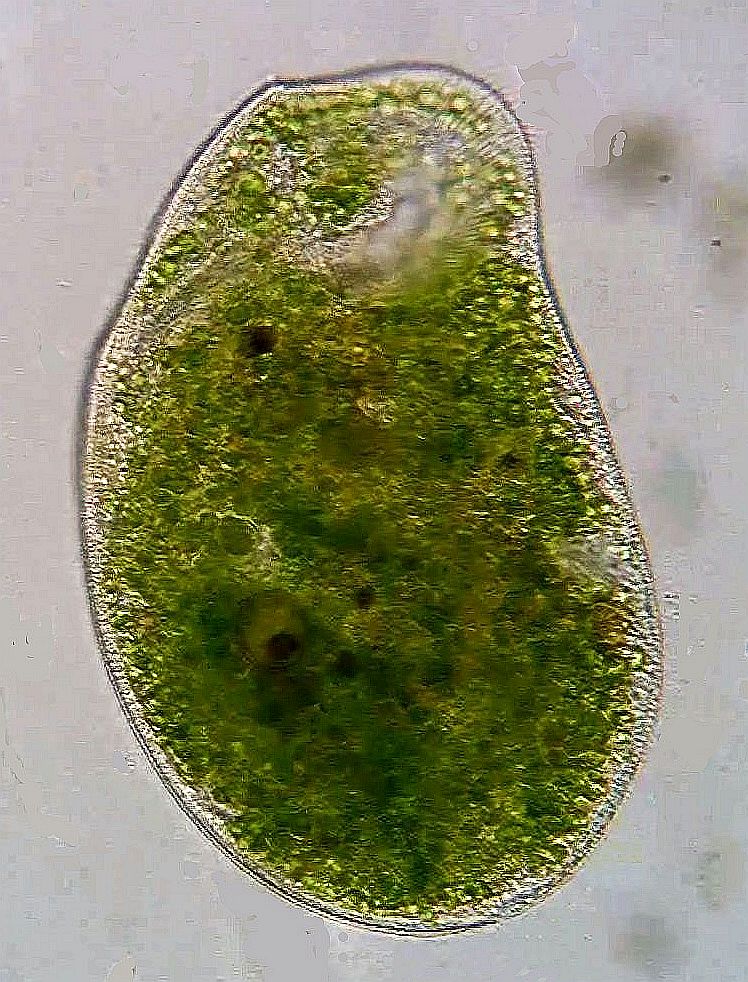Climacostomum on:
[Wikipedia]
[Google]
[Amazon]
''Climacostomum'' is a genus of unicellular
 The body is somewhat flexible but non-contractile, roughly ovoid or harp-shaped, and flattened from back to front. It has a large posterior
The body is somewhat flexible but non-contractile, roughly ovoid or harp-shaped, and flattened from back to front. It has a large posterior
 The species ''Climacostomum virens'' was first described in 1833 by
The species ''Climacostomum virens'' was first described in 1833 by
ciliate
The ciliates are a group of alveolates characterized by the presence of hair-like organelles called cilia, which are identical in structure to eukaryotic flagella, but are in general shorter and present in much larger numbers, with a differen ...
s, belonging to the class Heterotrichea.
The genus has one well-described species, ''Climacostomum virens'', which usually carries a symbiotic alga, a variety of ''Chlorella
''Chlorella'' is a genus of about thirteen species of single-celled green algae belonging to the division Chlorophyta. The cells are spherical in shape, about 2 to 10 μm in diameter, and are without flagella. Their chloroplasts contain the ...
'' that can be cultivated outside its host. Algae-free ( aposymbiotic) individuals are known, and a species that lacks algal symbionts, ''Climacostomum gigas'' Meunier 1907, has been identified, but not confirmed in recent literature.
In its cortex, ''Climacostomum virens'' has colorless granules structurally similar to the defensive pigmentocysts found in its fellow Heterotrichs, ''Stentor coreuleus'' and ''Blepharisma japonicum''. When ''Climacostomum'' is threatened by a predator, such as the ciliate ''Dileptus margaritifer,'' these cortical cysts release a defensive cytotoxin called Climacostol. This substance has been synthesized in the laboratory and found to be highly toxic to certain species of ciliates. It is believed that this toxicity is accomplished by the inhibition of mitochondrial respiration. It has been shown to have toxic effects on certain human cancer cells.
Appearance and characteristics
 The body is somewhat flexible but non-contractile, roughly ovoid or harp-shaped, and flattened from back to front. It has a large posterior
The body is somewhat flexible but non-contractile, roughly ovoid or harp-shaped, and flattened from back to front. It has a large posterior contractile vacuole
A contractile vacuole (CV) is a sub-cellular structure (organelle) involved in osmoregulation. It is found predominantly in protists and in unicellular algae. It was previously known as pulsatile or pulsating vacuole.
Overview
The contractile v ...
, and a characteristic posterior indentation (more pronounced in underfed individuals). The posterior vacuole surrounds the cytoproct (anus), through which food waste is eliminated. The macronucleus of ''Climacostomum virens'' is normally long and wormlike (vermiform). ''Climacostomum gigas'' is reported to have a compact, ovoid macronucleus.
The cell's most prominent feature is its large oral apparatus, which occupies most of the anterior region. This structure features an adoral zone of membranelles (AZM) partly encircling a wide oral cavity which opens into the cytopharyngeal pouch where digestive vacuoles are formed before they travel down the long, bent cytopharyngeal tube into the body of the cell.
''Climacostomum'' is found in fresh or brackish water, and feeds on suspended particles, such as bacteria and small flagellates.
When ''Climacostomum virens'' is grown in the dark, the algal endosymbionts normally found in it are reduced in number and the cytoplasm appears colorless. Peck et al. report that these are not contained within a membrane, but are in direct contact with the host's cytoplasm; however, other observers have noted the presence of perialgal vacuoles around the algae.
Classification
 The species ''Climacostomum virens'' was first described in 1833 by
The species ''Climacostomum virens'' was first described in 1833 by Christian Gottfried Ehrenberg
Christian Gottfried Ehrenberg (19 April 1795 – 27 June 1876) was a German Natural history, naturalist, zoologist, comparative anatomist, geologist, and microscopy, microscopist. Ehrenberg was an Evangelicalism, evangelist and was considered to ...
, under the name ''Spirostomum virens''. In 1859, Samuel Friedrich von Stein moved ''Spirostomum virens'' to a new genus, which he called ''Climacostomum''. In his Manual of Infusoria (1880), William Saville-Kent
William Saville-Kent (10 July 1845 – 11 October 1908) was an English marine biologist and author.
Early life
Born in the town of Sidmouth in Devon, South West England on 10 July 1845, William Saville-Kent was the son of Samuel Saville Kent (7 ...
rejected Stein's genus, assigning the species instead to ''Leucophrys patula'', which he described as synonymous with Ehrenberg's ''Spirostomum virens'' and ''Leucophrys patula'', as well as the ''Trichoda patula'' of O.F. Muller. However, the genus was retained by other researchers, including Alfred Kahl.
In a detailed study of its physical characteristics, published in 1972, Arthur J. Repak placed ''Climacostomum'' with the genus ''Fabrea'' in a new family he named ''Climacostomidae.''
Recently, molecular analyses have shown that, while the Heterotrichea as a whole are a monophyletic group, the taxon ''Climacostomidae'' is paraphyletic, the genus ''Fabrea'' being more closely related to the ciliates ''Eufolliculina'' and ''Maristentor'' than to ''Climacostomum''. Among the other Heterotrichs, ''Climacostomum'' appears to be most closely related to ''Chattonidium'' and ''Condylostoma
''Condylostoma'' is a genus of unicellular ciliate protists, belonging to the class Heterotrichea.
''Condylostoma'' is a genus of heterotrichous made up of large ciliated cells. The genus was discovered by Jean Baptiste Bory de Saint-Vincent in 1 ...
''.
Video gallery
References
{{Taxonbar, from=Q5133378 Ciliate genera Heterotrichea Articles containing video clips